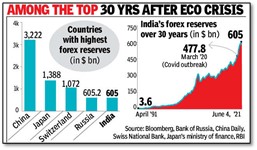Tuesday, 15th June 2021
Rare earth metals
In News
China's dominance in the rare earth metals is causing an alarm in the USA and Europe.
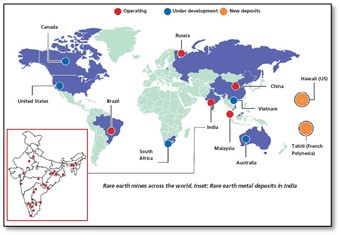
About the News
- Cause of urgency: The desire to accelerate rare earth production comes amid a shortage of semiconductors and mostly manufactured in Asia and exponential growth in demand for minerals that are linked to clean energy.
- High dependence on China: The United States imports 80 % and European Union gets 98 % of their rare earth supply from China. Frequent geopolitical friction has alarmed the western powers and compelled them to invest REM market that today are largely extracted and refined in China.
- China’s Monopoly: China possesses one-third of the world’s known deposits of rare earth metals and contributes 97 per cent of the global production. China’s soil is rich in europium and dysprosium, which are most important for the production of high-tech material. Despite their great use, most countries have in the past distanced themselves from undertaking rare earth mining because the process is environmentally damaging. Acid leaching, the standard method used in extracting rare earths is expensive and hazardous.
What are Rare Earth Metals (REM) and why are they so important?
- About REM: Rare earth metals comprise of 17 elements, including yttrium, scandium and members of lanthanide series in the Periodic Table. These metals do not occur in a free state. They are found in mineral oxide ores. Their name is something of a misnomer. While they are hard to extract, they are quite abundant in the earth’s crust. In fact, cerium is the 25th most abundant metal in the earth’s crust.
- Properties of significance: They (rare earth metals) are valuable because they are stable at high temperatures in which electronic devices operate. Their importance lies in their unique electronic, optical and magnetic characteristics, which cannot be matched by any other metal or synthetic substitute.
- Usage: Rare earth minerals with names like neodymium, praseodymium and dysprosium are crucial to the manufacture of magnets used in industries of the future like wind turbines and electric cars. They are already present in consumer goods such as smartphones, computer screens and telescopic lenses. Others have more traditional uses, like cerium for glass polishing and lanthanum for car catalysts or optical lenses.
India and rare earth metals
- India has the world’s fifth-largest reserves of rare earth elements, nearly twice as much as Australia, but it imports most of its rare earth needs in finished form from China. Significant rare earths minerals found in India include ilmenite, sillimanite, garnet, zircon, monazite and rutile, collectively called Beach Sand Minerals (BSM). India has almost 35 per cent of the world’s total beach sand mineral deposits. Indian RE reserves are richer in lighter fractions and are deficient in heavier ones.
- Indian Rare Earths Ltd (IRE) and Kerala Minerals and Metals Ltd (KMML) are operating the mineral sands separation.
Mustard oil blending banned
In News
The Food Safety and Standards Authority of India has declared to end the practice of blending mustard oil with other edible oil (like from palms, rice bran, etc) for production of Multi-Sourced Edible Vegetable Oils (MSEVOs).

About the News
- As per the FSSAI regulations, blending of two edible oils is permitted, provided the proportion by weight of any edible vegetable oil used in the blending process is not less than 20 per
- FSSAI has banned blending of mustard oil with other edible oils to ensure purity and safety of these products.
- It will act as an encouragement to increase the sowing area under mustard crop. Higher domestic production of mustard oil will lead to a fall in edible oil imports to some extent.
Why was blending of Mustard oil started?
- Benefits of Blending: Blending of mustard oil with other edible oils has been considered to bolster nutritional profile, taste and quality. The Union health ministry had allowed blending in edible vegetable oil in a notification in 1990.
- The unblended mustard oil controversy: In 1998, Delhi and other north Indian states witnessed the dropsy epidemic — a disease that caused swelling in the body due to the build-up of fluid in tissues. Investigation found adulteration of mustard oil with Argemone Mexicana, a kind of weed that grows with yellow flowers. The fear among the masses eventually impacted the sales of mustard oil and this void was filled with refined oils.
What has been the impact of Blending of Mustard oil?
- High amounts of cheap blending oils: Experts claim that the processing industry took advantage of blending. Cheap palm oil would be blended up to 80 per cent in mustard oil at times. As a result, profits of mustard farmers dried up, which discouraged them from cultivating the crop.
- Oil imports rise: This eventually has led to India’s increasing dependency on oil import over the last two decades. In 1990-91, India was self-reliant in mustard oil production and produced 98 per cent of oil needed, due to the Technology Mission on Oilseeds (TMO) policy, which aimed to improve production and agricultural land for mustard.
- Decrease in production: In the last 25 years, the agricultural land for mustard oil production hasn’t increased. The policies have been ineffective in supporting mustard production. Rather, import of palm oil has been supported and even the import duty was reduced to zero at a point.
Deficit Financing
In News
Former RBI governor Subbarao said that the current situation does not call for the RBI directly monetising the deficit.
About the News
- The monetary policy committee (MPC) has decided to continue with the accommodative stance as long as necessary to revive and sustain growth on a durable basis. It has also been decided to undertake G-SAP 2.0 in Q2:2021-22 and conduct secondary market purchase operations of ₹20 trillion to support the market. This will be done through printing money. Hence, between April and September this year, RBI has plans of printing ₹2.2 trillion and buying government securities.
- Printing money will help the government in this way, especially during times when tax collections are likely to slow down. The government is expected to borrow ₹1 trillion during the course of this financial year. Thus, the RBI is financing the deficits of the government.
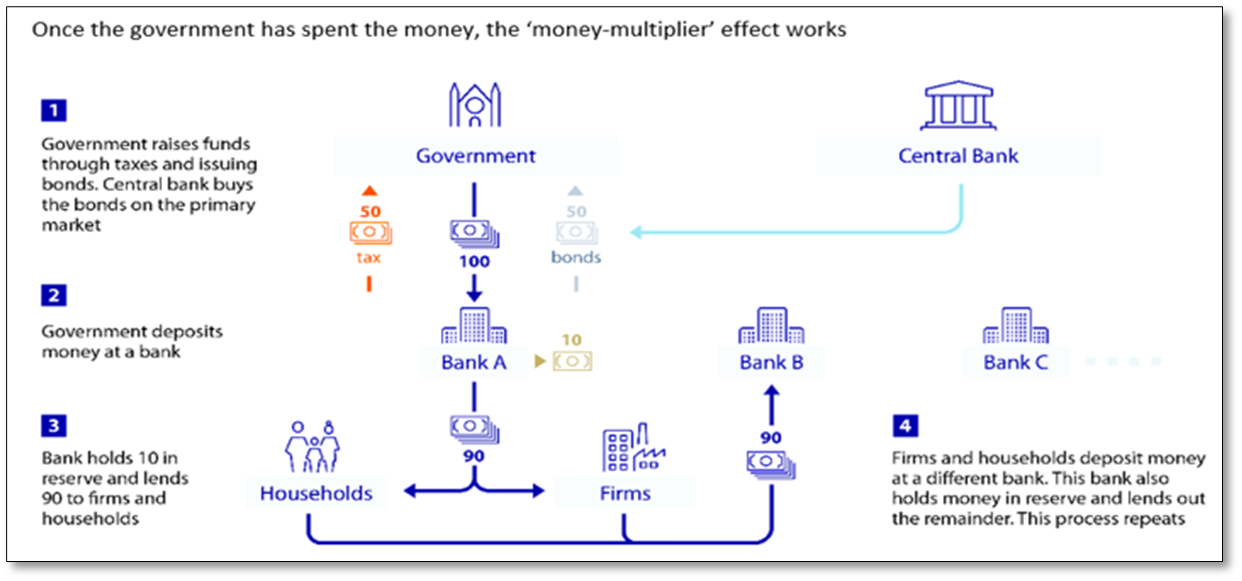
What is Deficit Financing or Monetization of Deficit?
- Most of the time, governments have two basic choices for financing their deficits: they can borrow (issue debt) or raise taxes. Monetization represents a third, unconventional choice that governments may consider in crises like the current one.
- Simply put, monetization—also known as “money-financed fiscal programs” or “money-printing”—occurs when the government finances itself by issuing non-interest-bearing liabilities, that is, either currency in circulation or central bank reserves.
- When the government borrows from the Reserve Bank of India, it merely transfers its securities to the Bank. On the basis of these securities the bank issues more currency and puts them into circulation on behalf of the government. This amounts to the creation of money.
Why is monetization of deficits so common, despite its visible drawbacks?
- The inevitability in developing countries: The developing countries aim to achieve higher economic growth, which requires high capital resources. Due to inadequate capital resources and inability to increase tax rates for financing economic development, deficit financing route to generate sufficient revenue becomes inevitable.
- Crisis management: The onset of the COVID-19 crisis has forced governments to spend heavily to combat the considerable economic and public-health impacts. As deficits continue to climb and external investors remain cautious about where to place their capital, monetization has re-entered the conversation as a potential avenue to avoid massive debt burdens.
- Capital Formation: Deficit financing, undertaken for the purpose of building up useful capital during a short period of time, is likely to improve productivity and ultimately increase the elasticity of supply curves. And the increase in productivity can act as an antidote against price inflation.
- Cost Free method: In India, deficit financing is associated with the creation of additional money by borrowing from the Reserve Bank of India. Interest payments to the RBI against this borrowing come back to the Government of India in the form of profit, generated through increase in economic productivity. Thus, this borrowing or printing of new currency is virtually a cost-free method.
- Good inflation: Low inflation can have deleterious impact on taxes, wages and ability of the government to take on more debt. Deficit financing ensures a backstop to ensure a certain amount of inflation in the economy, enabling the government to inflate away at part of the new debt it is taking on to provide a safety net for the economy.
Problems associated with Monetization of Deficit
- Rise in Inflation: Printing new currency notes increases the flow of money in the economy. This leads to increase in inflationary pressures which leads to rise of prices of goods and services in the country. Deficit financing is inherently inflationary. Since deficit financing raises aggregate expenditure and, hence, increases aggregate demand, the danger of inflation looms large.
- Discourages investment: Deficit financing affects investment adversely. Inflation increases the cost of production which de-motivates the investors. Aggressive monetization can devalue the currency, causing foreign investors to lose confidence and pull out money, putting the existing fiscal financing plan at risk.
- Debt-GDP ratio: Borrowings increase government debt and negatively impacts debt-to-GDP ratio which is already worsening because of growth slowdown and possible contraction because of COVID-19 lockdown.
- Fiscal Discipline: Governments that have access to the printing currency as a form of financing may also exercise far less fiscal discipline than otherwise. Issuing debt without the expectation of repayment could lead to governments spending excessively and overheating the economy.
- Lowers savings: Deficit financing leads to inflation and inflation affects the habit of voluntary saving adversely. In fact, it is not possible for the people to maintain the previous rate of saving due to rising prices.
- Independence of RBI: When RBI is printing money as part of its liquidity operations, it is in the driver's seat, deciding how much money to print and how to channel it into the system. In contrast, monetisation is seen as a way of financing the government's fiscal deficit, with the quantum and timing of money to be printed being decided by the government's borrowing requirement rather than the RBI's monetary policy. That will be seen as RBI losing control over the money supply, which will erode the credibility of both the RBI and the government with costly macroeconomic implications
- Collateral damage: Monetization can circumvent the market-pricing mechanism in secondary markets by allowing the government to issue debt at lower interest rates. The cheap credit for the government can lead to moral hazard concerns if the central bank commits to low interest rates along the yield curve. Excessive spending could also lead to crowding out.
Way Forward
- As deficit financing is a necessary evil for every economy struggling with an excess of government expenditure, the success of it depends on how anti-inflationary measures are employed to combat the negative impacts of inflation.
- Instead of borrowing in the market, the government can raise a part of its borrowing requirements by issuing special or specific bonds to the public. Appropriately priced and structured, they can provide relief to savers who are short-changed by the low-interest rates on bank fixed deposits. Moreover, such bonds will not add to the money supply and will not, therefore, interfere with RBI's liquidity management.
Question: Analyze the issues associated with deficit financing.
Primary Sources: https://www.livemint.com/economy/rbi-money-printing-should-be-last-option-govt-can-consider-covid-bonds-subbarao-11623240620205.html
https://economictimes.indiatimes.com/budget-faqs/what-is-deficit-financing/articleshow/73329358.cms
https://som.yale.edu/blog/monetization-of-fiscal-deficits-and-covid-19-primer
https://economictimes.indiatimes.com/news/economy/indicators/view-monetisation-of-deficits-fetters-are-more-in-our-mind/articleshow/75159905.cms?from=mdr
Secondary Sources: https://www.economicsdiscussion.net/public-finance/deficit-financing/deficit-financing-meaning-effects-and-advantages/17460
https://www.indianfolk.com/deficit-financing-necessary-evil-edited-anu-vensila/
https://mpra.ub.uni-muenchen.de/93118/1/MPRA_paper_93118.pdf
https://economics.rabobank.com/publications/2020/july/should-india-print-money-to-fight-covid-19/
This Day in History - Right to Information Act
On 15 June 2005, President APJ Abdul Kalam gave his assent to the national Right to Information Act 2005. It is a law to provide for setting out the practical regime of right to information for citizens to secure access to information under the control of public authorities. It promotes transparency and accountability in the working of every public authority. As a party to the International Covenant on Civil and Political Rights (ICCPR), India is under an international obligation to effectively guarantee the right to information as per Article 19 of the ICCPR. The right to information campaign in India began with the Mazdoor Kisan Shakti Sangathan (MKSS) movement.

Sources: https://www.theindiaforum.in/article/defanging-rti-step-step
https://www.humanrightsinitiative.org/content/national-level-rti
Image of the Day- UAV Refuelling
For the first time in history, an unmanned aircraft refuelled another in mid-air. During a test flight on June 4, a Boeing-owned unmanned MQ-25 T1 aircraft refuelled a U.S. navy F/A-18 fighter jet in mid-air. During the initial part of the flight, the U.S. Navy F/A-18 Super Hornet flew in close formation behind the MQ-25 to ensure stability prior to refuelling, a manoeuvre that required as little as 20 feet of separation between the aircrafts. Both aircrafts flew at operationally relevant speeds and altitudes. The MQ-25 then extended the hose and drogue from its aerial refuelling store (ARS), and the F/A-18 jet moved in to "plug" with the unmanned aircraft and receive jet fuel.
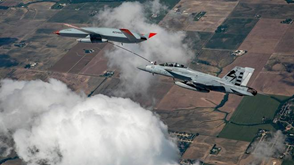
EnVision mission
- Context: The European Space Agency (ESA) has announced EnVision mission as its next orbiter to visit Venus, to be sent in the 2030s.
- The spacecraft will study the planet’s atmosphere and surface, monitor trace gases in the atmosphere and analyse its surface composition. A radar provided by NASA will help to image and map the surface.
- EnVision will follow NASA’s DAVINCI+ and VERITAS missions to Venus and another ESA-led mission to Venus called Venus Express (2005-2014) that focussed on atmospheric research and pointed to volcanic hotspots on the planet’s surface.

Primary source: https://indianexpress.com/article/explained/explained-european-space-agencys-envision-mission-to-venus-7354821/
Pyrostria Laljii
- Context: A 15-meter-tall tree that belongs to the genus of the coffee family has recently been discovered in the Andaman Islands.
- The new species, Pyrostria laljii, is also the first record of the genus Pyrostria in India.
- Plants belonging to the genus Pyrostria are usually found in Madagascar but the recently discovered species is new to science.
- The tree is distinguished by a long stem with a whitish coating on the trunk, and oblong-obovate leaves with a cuneate base, and was first reported from South Andaman’s Wandoor forest.
- Pyrostria laljii has been assessed as ‘Critically Endangered’based on the International Union for Conservation of Nature’s (IUCN) Red List criteria.
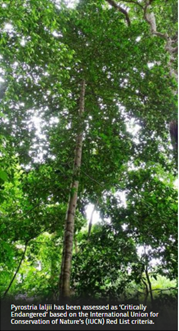
Primary source: https://www.thehindu.com/news/national/other-states/15-metre-tree-discovered-in-andaman-nicobar-islands/article34806204.ece
Picture source: https://www.thehindu.com/news/national/other-states/15-metre-tree-discovered-in-andaman-nicobar-islands/article34806204.ece
PASIPHAE Project
- Context: The Wide Area Linear Optical Polarimeter (WALOP),a vital instrument for the PASIPHAE Project, is being developed at Inter-University Centre for Astronomy and Astrophysics (IUCAA), India.
- Polar-Areas Stellar-Imaging in Polarisation High-Accuracy Experiment (PASIPHAE) is an international collaborative sky surveying project.
- It is an opto-polarimetric surveyaiming to measure the linear polarization from stars. It will focus on capturing starlight polarization of very faint stars that are so far away that polarization signals from them have not been systematically studied.
- The distances to these stars will be obtained from measurements of the GAIA satellite (which is on amission to chart a three-dimensional map of our Galaxy, the Milky Way)
- The survey will be conductedconcurrently from the South African Astronomical Observatory in Sutherland, South Africa in the southern hemisphere, and the Skinakas Observatory in Crete, Greece, in the north.
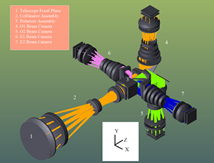
Primary source: https://indianexpress.com/article/explained/explained-how-pasiphae-will-peep-into-the-unknown-regions-of-the-sky-7357628/
Picture Source: http://pasiphae.science/news
Operation Oliva
- Context: Operation Olivia has been brought into service by the Indian Coast Guard to rescue Olive Ridleys.
- Every year, the Indian Coast Guard’s “Operation Olivia”, initiated in the early 1980s, helps protect Olive Ridley turtles as they congregate along the Odisha coastfor breeding and nesting from November to December.
- It also intercepts unlawful trawling activities.
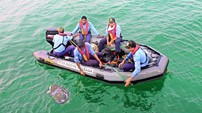
Primary source: https://www.thehindu.com/news/national/operation-olivia-to-the-rescue-of-olive-ridleys/article34799480.ece
Picture source: https://www.deccanchronicle.com/nation/current-affairs/261018/indian-coast-guards-operation-olivia-to-start-november-1.html
Why fiscal prudence in a pandemic year?
Essence: The real gross domestic product (GDP) at constant (2011-12) prices in 2020-21 is set to contract by 7.3 per cent due to the Covid-19 pandemic, according to the Ministry of Statistics and Programme Implementation. This article highlights the concerns of declining State expenditure and revenues despite relaxation of the Fiscal Responsibility and Budget Management (FRBM) rules, which allowed States to borrow up to five per cent of their GDP.
Why you should read this article?
- Know about the trends in revenue and capital receipts of High and Low income States during 2020-21.
- Have an overview of State’s expenditure during the pandemic.
- Understand how the expenditure patterns of States is in contradiction to the demand of the pandemic struck economy.
Article Link: https://www.thehindubusinessline.com/opinion/why-fiscal-prudence-in-a-pandemic-year/article34815104.ece
From G-7 summit, a template for Indian engagement with the West
Essence: Editorial is deciphering the messages & core issues linked to India’s alignment with these G-7 economies. PM has proclaimed that India is a “natural ally” of the G-7 and its partners. It is being said that, recently concluded Cornwall summit (G-7 summit 2021 in Cornwall,UK) can be seen as the beginning of an institutionalisation of India’s cooperation with the West. The case for a “coalition of democracies” was certainly gaining ground over the last two decades within American academia and the political class. At the same time, there is a strong view that the door must be kept open for engagement with China on issues like climate change while calling out its unacceptable policies. When it comes to India & West axis, there is need for sustained consultations on a range of new challenges presented by digital technologies, including radicalisation, disinformation, electoral interference, cyber-attacks, and the role of large social media companies.
Why you should read this article?
- To know about the recent shifts in US Europe axis & possibilities for India.
- To gain understanding on evolution of India’s relations with west from the time of former PMs like Mr. Atal Bihari Vajpayee, Mr Manmohan Singh to present.
- To know about “coalition of democracies”, a major foreign policy call made by US.
Article Link: https://indianexpress.com/article/opinion/columns/g-7-nations-meet-statement-on-open-societies-climate-change-india-7359182/
From G-7 summit, a template for Indian engagement with the West
Essence: Editorial is deciphering the messages & core issues linked to India’s alignment with these G-7 economies. PM has proclaimed that India is a “natural ally” of the G-7 and its partners. It is being said that, recently concluded Cornwall summit (G-7 summit 2021 in Cornwall,UK) can be seen as the beginning of an institutionalisation of India’s cooperation with the West. The case for a “coalition of democracies” was certainly gaining ground over the last two decades within American academia and the political class. At the same time, there is a strong view that the door must be kept open for engagement with China on issues like climate change while calling out its unacceptable policies. When it comes to India & West axis, there is need for sustained consultations on a range of new challenges presented by digital technologies, including radicalisation, disinformation, electoral interference, cyber-attacks, and the role of large social media companies.
Why you should read this article?
- To know about the recent shifts in US Europe axis & possibilities for India.
- To gain understanding on evolution of India’s relations with west from the time of former PMs like Mr. Atal Bihari Vajpayee, Mr Manmohan Singh to present.
- To know about “coalition of democracies”, a major foreign policy call made by US.
Article Link: https://indianexpress.com/article/opinion/columns/g-7-nations-meet-statement-on-open-societies-climate-change-india-7359182/
What This Lady Has Done For Over 5000 Slum Children Has An Important Lesson For All Of Us
Aim of ethics is to do good and achieve the highest good (Summum Bonum)
- We all have a little good in ourselves. We just need a little push to put the good into action.
- An inspirational speech, a role model or sometimes just small incidents in our routine lives to ignite the fire to bring a change.
- Inspired by her father, Beena Rao is one such person who is changing the lives of thousands of slum children
About Beena Rao
- She introduced Prayas, a free coaching institute for slum children.
- Initially having started with teaching 2-3 children, she and the team now teach around 1,200 students at eight different centres.
- She conducts coaching for the students of classes 3rd to 8th for free.
- Apart from teaching basic subjects, she imparts moral education, extra-curricular activities, yoga, mannerisms, and other aspects.
Journey has not been easy
- Convincing the children, their families and building trust were few of the challenges.
- Getting dedicated volunteers with the right spirit has also been challenging.
My religion is simple, My religion is kindness
- As per her, every day is a lesson. People search for God, she sees God in these children and when she sees the positive changes in these kids, that satisfaction cannot be measured
Where can we use this case study:
- An an example for Altruism, Kindness, Selfless (Mentioned as a value by Nolan Committee), Humanitarianism.
- Role of a teacher and education for bringing change in society
- Lessons from the ideas of leaders, teachers etc
Share the article
Get Latest Updates on Offers, Event dates, and free Mentorship sessions.

Get in touch with our Expert Academic Counsellors 👋
FAQs
UPSC Daily Current Affairs focuses on learning current events on a daily basis. An aspirant needs to study regular and updated information about current events, news, and relevant topics that are important for UPSC aspirants. It covers national and international affairs, government policies, socio-economic issues, science and technology advancements, and more.
UPSC Daily Current Affairs provides aspirants with a concise and comprehensive overview of the latest happenings and developments across various fields. It helps aspirants stay updated with current affairs and provides them with valuable insights and analysis, which are essential for answering questions in the UPSC examinations. It enhances their knowledge, analytical skills, and ability to connect current affairs with the UPSC syllabus.
UPSC Daily Current Affairs covers a wide range of topics, including politics, economics, science and technology, environment, social issues, governance, international relations, and more. It offers news summaries, in-depth analyses, editorials, opinion pieces, and relevant study materials. It also provides practice questions and quizzes to help aspirants test their understanding of current affairs.
Edukemy's UPSC Daily Current Affairs can be accessed through:
- UPSC Daily Current Affairs can be accessed through Current Affairs tab at the top of the Main Page of Edukemy.
- Edukemy Mobile app: The Daily Current Affairs can also be access through Edukemy Mobile App.
- Social media: Follow Edukemy’s official social media accounts or pages that provide UPSC Daily Current Affairs updates, including Facebook, Twitter, or Telegram channels.

